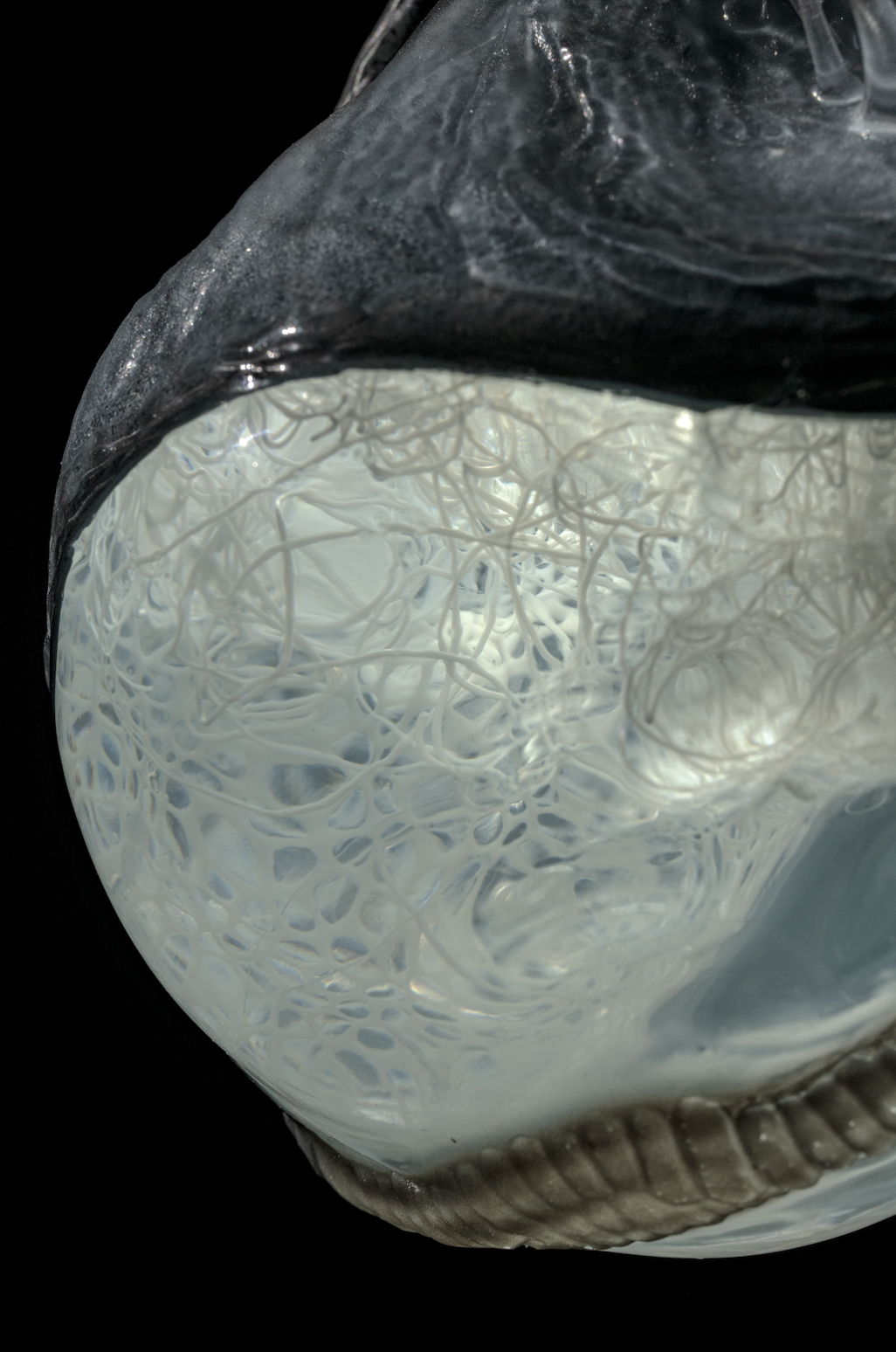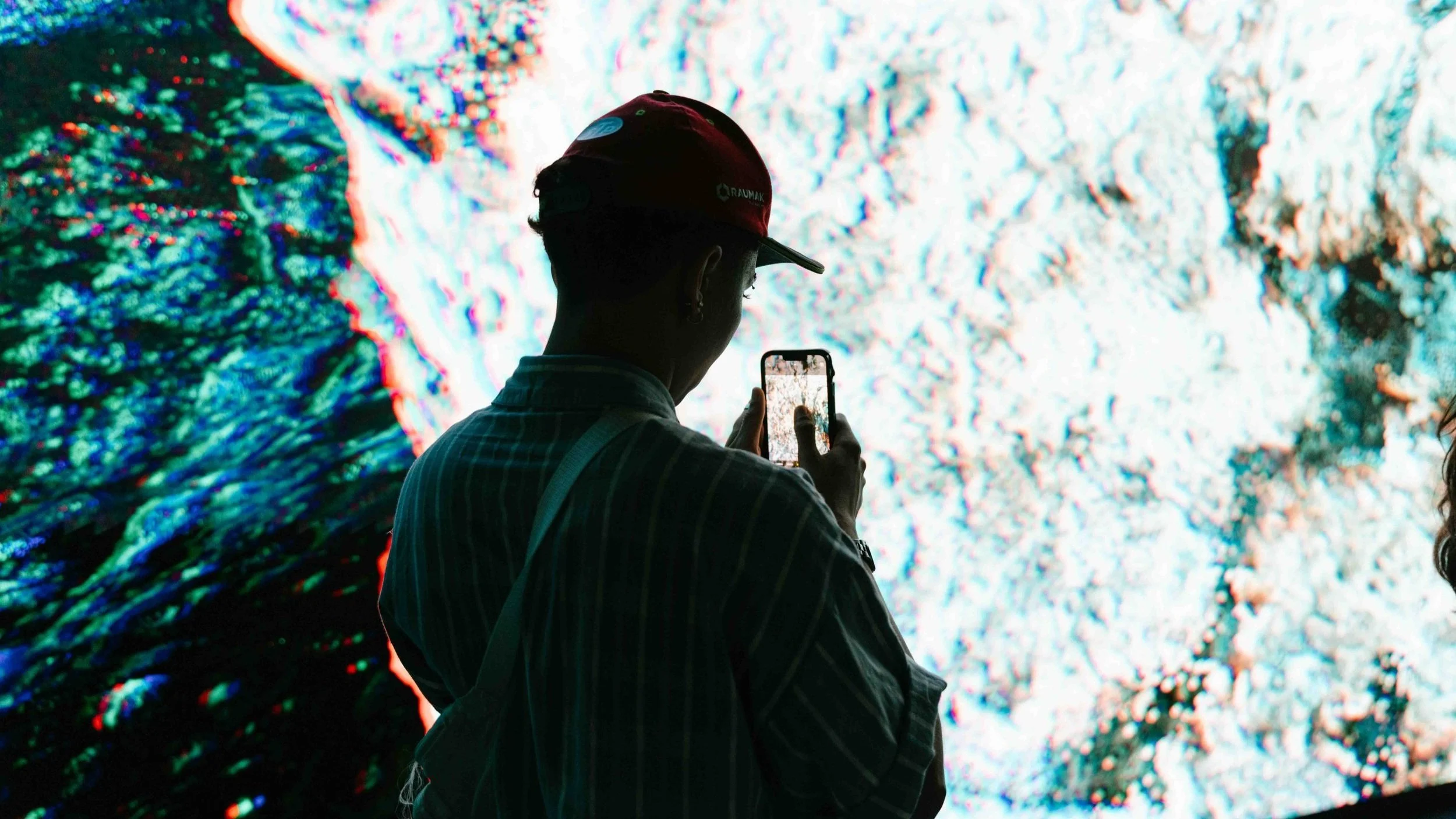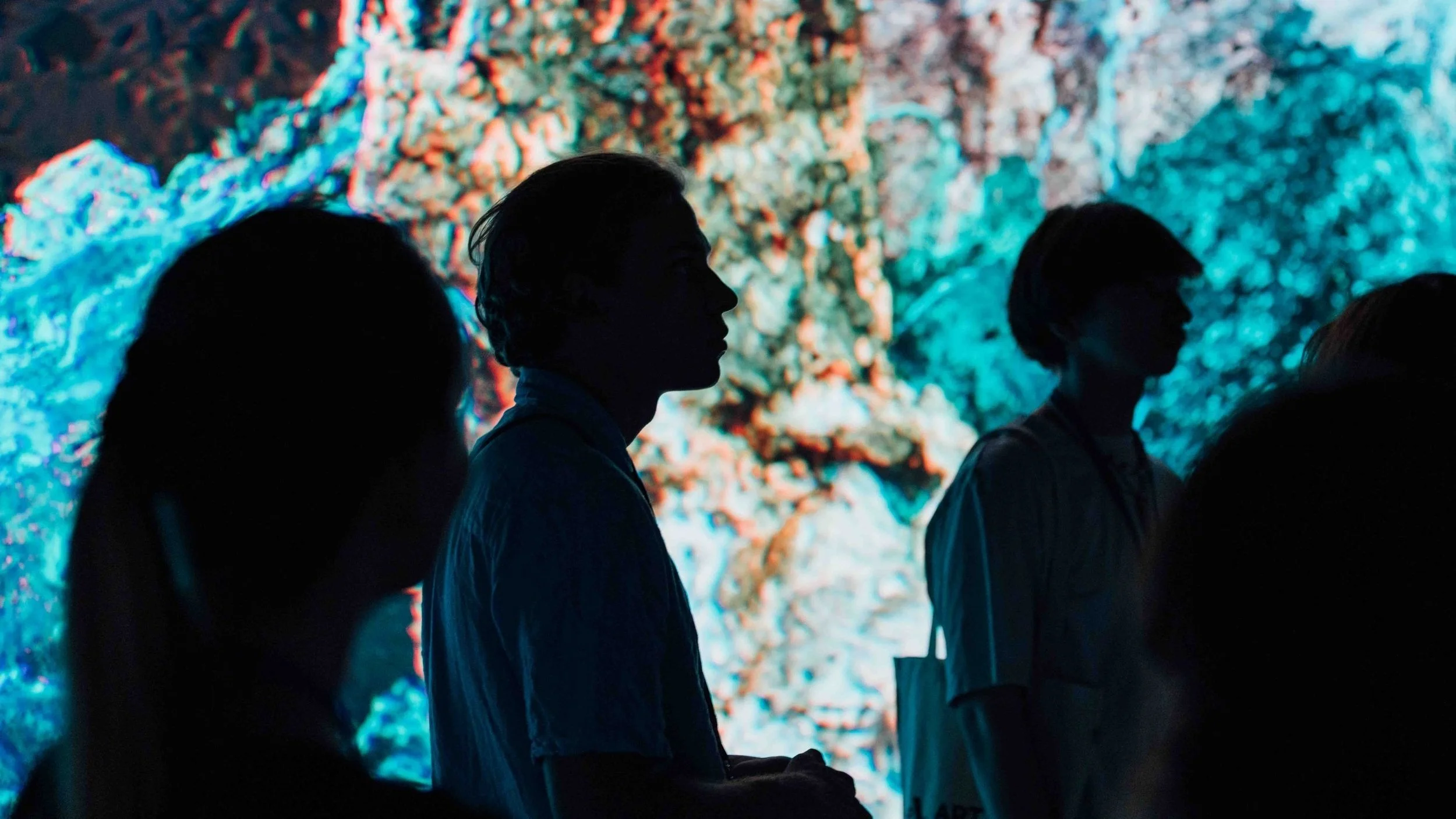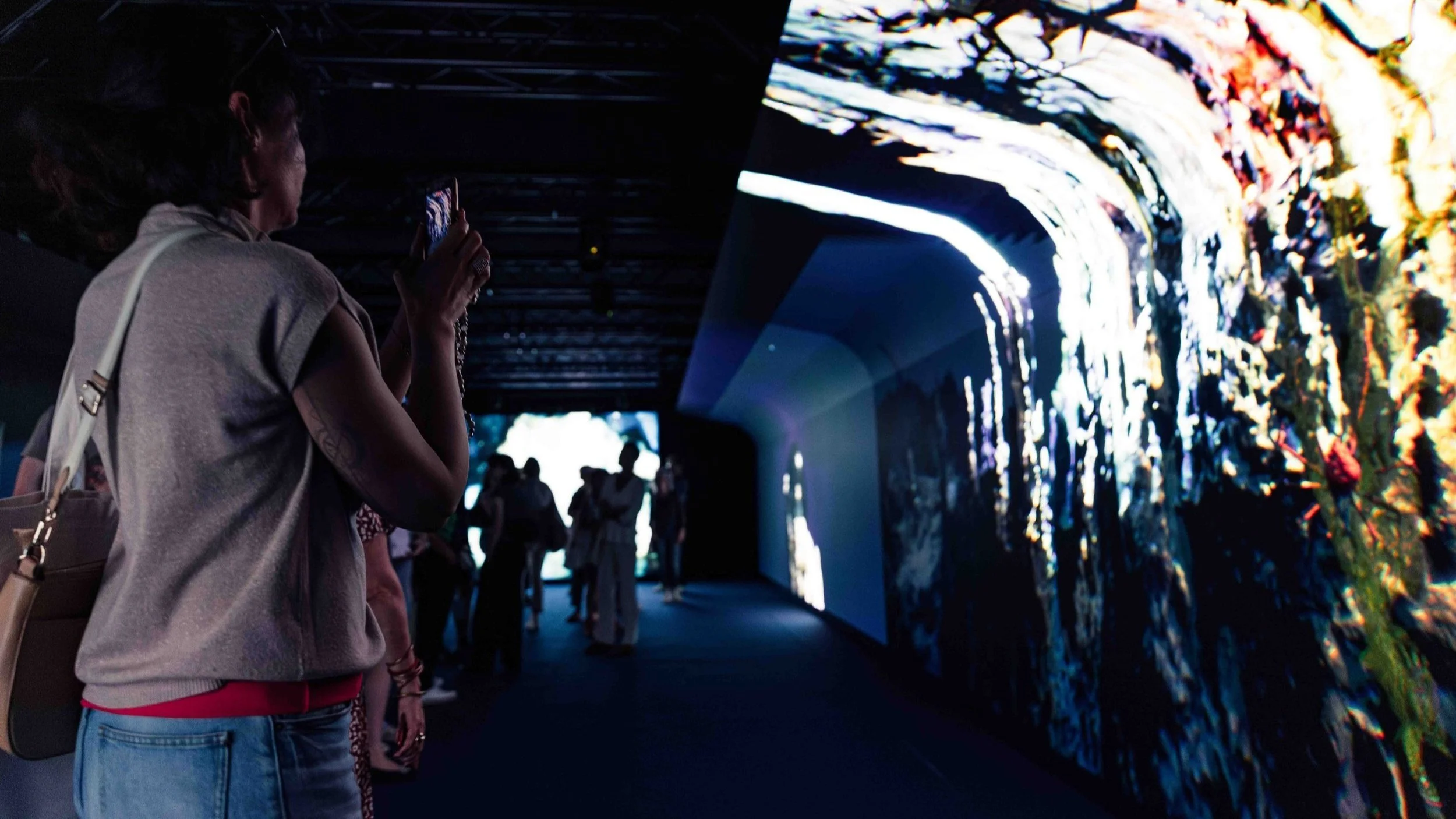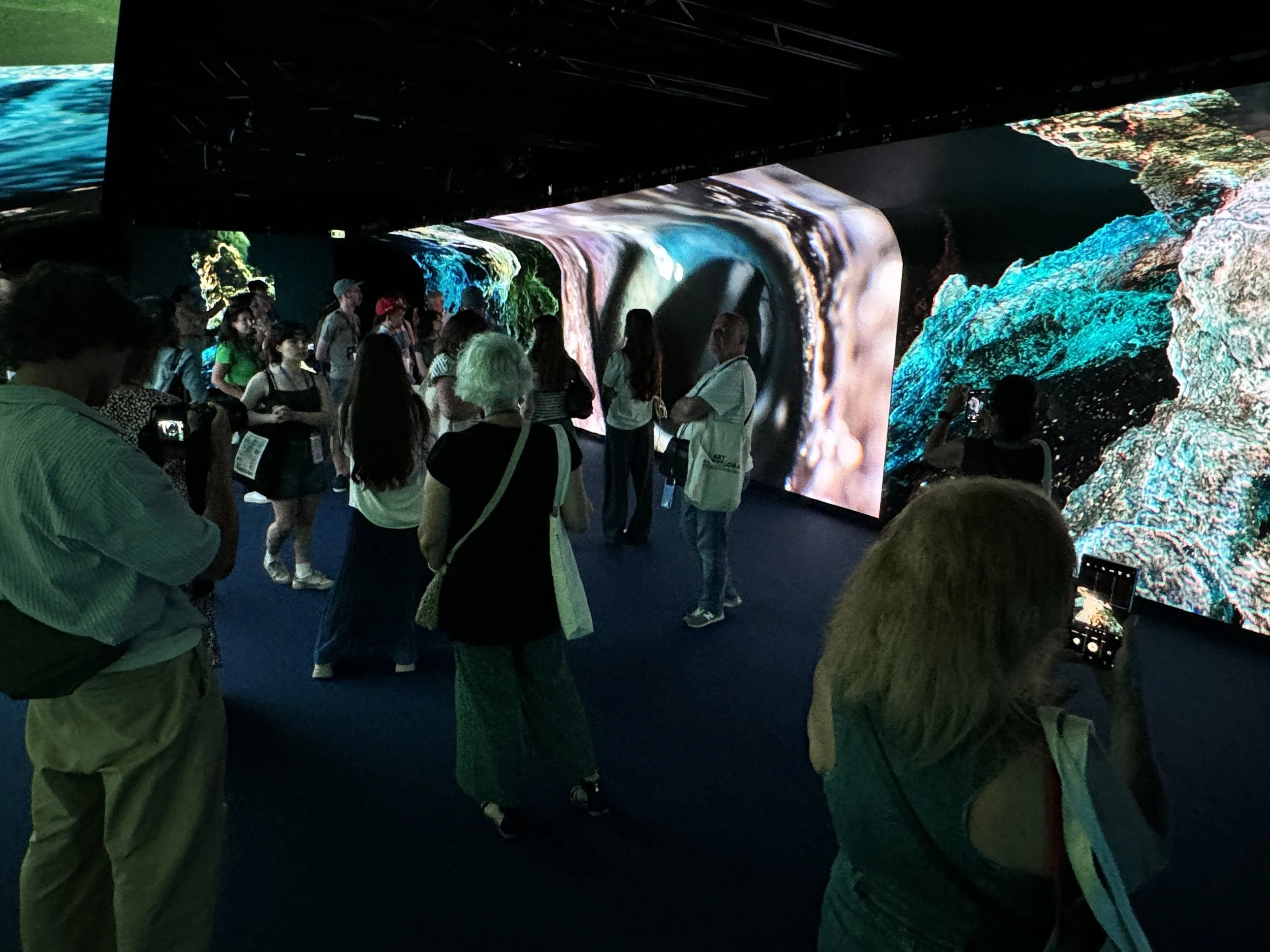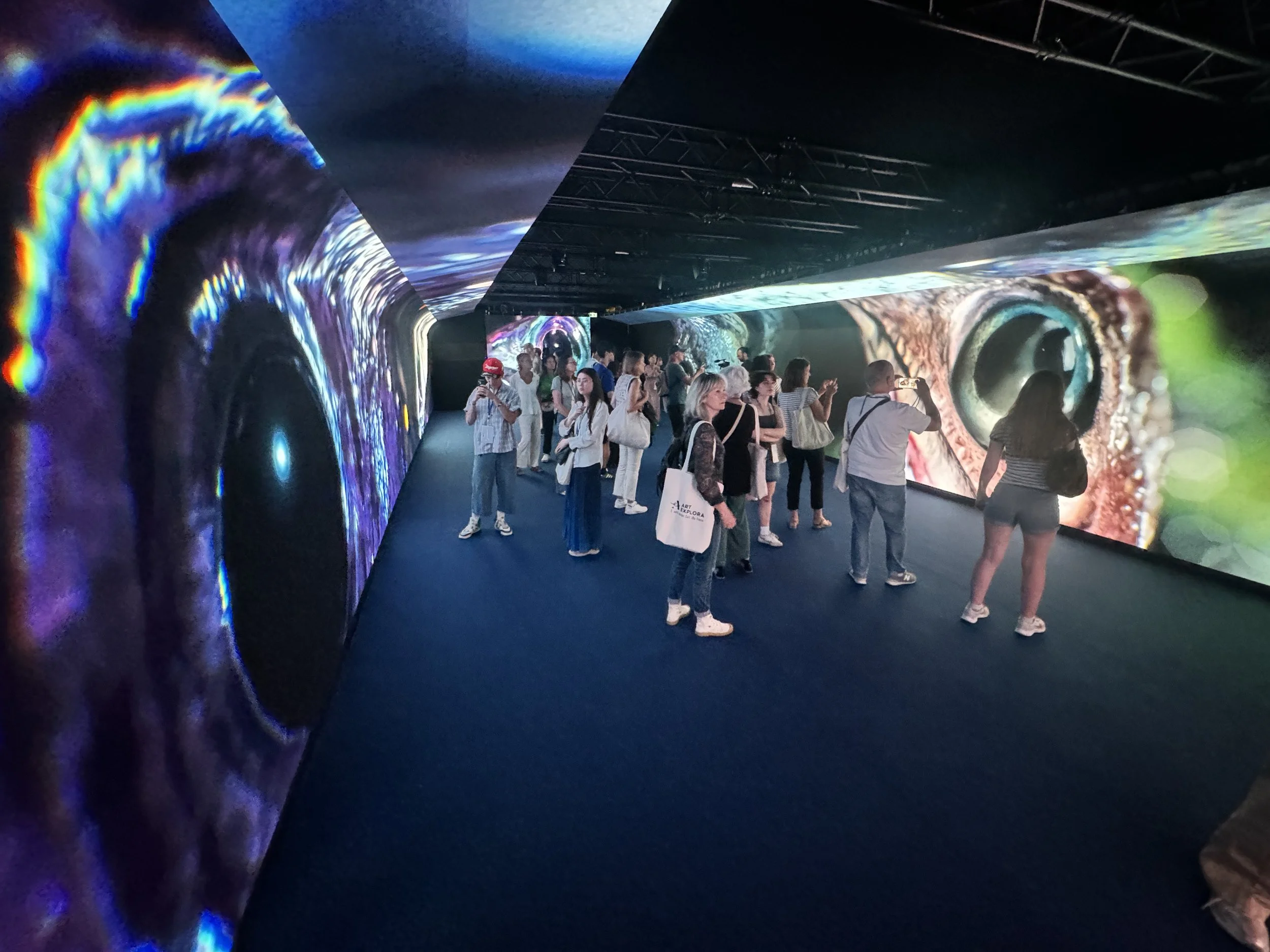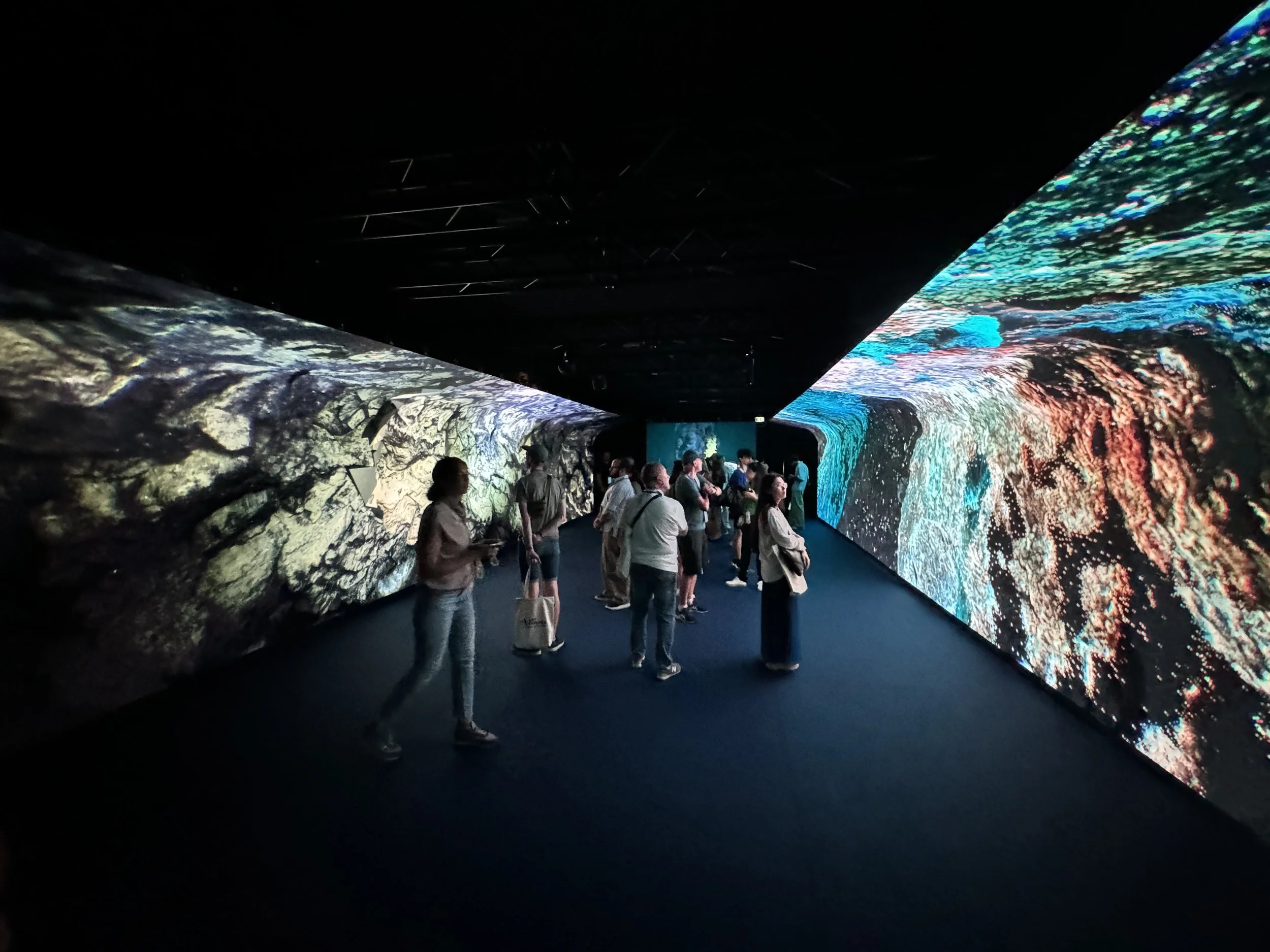PSYCHOSPHERE (2025)
Moving Image & Spatialised Sound.
Billions of years ago, life emerged in volcanic vents deep beneath the ocean’s surface. Even today, this common heritage resonates with us, as a profound sense of interconnectedness between all living species on Earth. Exploring this in collaboration with scientist and writer Melanie Challenger, Psychosphere traces transitions from the inanimate to the animate, and how matter, movement and psyche interconnect.
To create Psychosphere, Steensen used his own original underwater recordings from the Azores and outside Stromboli, alongside material from a newly found arctic deep sea volcanic landscape documented by research vessel REV Ocean/REV Aurora in the Barents Sea. Within Psychosphere, field recordings of life in the deep sea merge with man made musical compositions. Fossils of long extinct sea lilies and ammonites appear alongside living fish species, as well as sculptures of synthetic life forms. Songs and sounds from various ocean species have been integrated thanks to Francesca Thyssen-Bornemisza and the Sounds Too Many archive commissioned by TBA21–Academy.
Additionally, Psychosphere’s spatial and musical composition made in collaboration with Lugh O’Neill, includes contributions by the renowned Danish accordion player Bjarke Mogensen. The accordion, originally invented as a mechanical reproduction of breathing, creates in Psychosphere, a sense of encountering something alien and nostalgic at the same time. Psychosphere transforms our physical dimension into spatial instrument – a place where life’s cadence can be explored.
Installation Views: Jakob Kudsk Steensen, Psychosphere, 2021. Cisternene, Copenhagen Denmark. Photos by David Stjernholm.
Cisternene Installation
16 March - 30 November 2025
Copenhagen, Denmark
Psychosphere was originally commissioned by Cisternerne (Frederiksberg Museums), a subterranean cavernous space, capable of being flooded across its 4320 square metres that echo with Psychosphere’s deep-sea sounds. As part of its original installation and connecting to this sonic material, includes three distinct series of sculptures —crafted from glass, fiberglass, and resin— that respond in real time and dynamically through interactive light and sound.
Orogeny, a limited series of interactive glass sculptures, take their departure from Steensen’s travels to some of the earth’s hottest deserts collecting and scanning ancient rock sediments - ancient vessels of water systems now vanished. Amorphous, an additional limited series of resin and fiberglass sculptures, are an amorphous combination of Steensen’s sketches combine with extinct sea lily specimens that once dominated our ocean floors.
At the heart of the installation stands a singular, freestanding amorphous sculpture - Abiogenesis. The theory of abiogenesis delves into the mystery of life birthing from our deep seas, suggesting that life emerged through a gradual, natural progression—from simple organic compounds to increasingly complex organisms capable of movement, interaction, and eventually, sentience. Abiogenesis also takes its departure from Steensen’s hydrothermal and deep sea scientific material…Steensen using this as key reference material to sketch designs that were then transformed into virtual models and hand sculpted by master palaeontology experts Studio Megaton and 10 Tons in Copenhagen.
Amorphous also being made in close collaboration with Studio Megaton and 10 Tons in Copenhagen to evoke an eco-fiction; combining techniques usually applied to biological model making, with that of speculative science fiction under the creative direction of Steensen.
Installation Views: Jakob Kudsk Steensen, Psychosphere, 2021. Cisternene, Copenhagen Denmark.
Photos by David Stjernholm.
United Nations Ocean Conference 2025
ArtExplora Palais des Expositions (La Baleine), Nice France 02-13 June 2025
In partnership with ArtExplora and as part of the United Nations Ocean Conference 2025, Psychosphere was adapted as an immersive LED tunnel with corresponding site specific spatialised sound. This installation, along with the 2025 Conference programming, added to a sea of voices across art, science, economic, and politics to shift perspectives on how we define life within our seas and protect it long term.
Current definitions do not articulate or recognise intrinsic rights of ecosystems or marine species, with common heritage to mankind rather than all-kind as a prohibitor towards mismanagement of ocean “resources”. This terminology and perspective must change if we are to accurately protect the ocean and our deep seas.
“The voice of the living originated in the deep sea,
Where volcanic vents, under crushing pressure,
Turned Earth's crust into strands of DNA.
Bubbles rose from underwater chimneys,
Organ pipes sounding the heartbeat,
Of our planet’s molten core.
There is something sacred, almost occult,
In the scientific pursuit of life’s origin.
Abiogenesis—life from lifelessness—
Counters panspermia’s cosmic whispers:
That life may have come from celestial sentience.
Psyche was not born from words or thought,
But through interspecies chorus. Eyes, limbs, shifting forms—
Metabolism forging connection,
Movements and bodies shaping the world,
Building cadence before language was ever sung.
Cadence itself makes worlds emerge,
And vanish. To look at the world is to feel it
Looking back.
Once, giant sea lilies covered the ocean floors,
Forests of animal-plants swaying in acidifying seas.
As CO₂ rose, they perished—like coral today—
Extinct for 200 million years,
Their silence echoes in our seas.
The free-floating hyoid bone in your throat
Came from a fish 400 million years ago.
It gave that fish the power,
To open its mouth wide, to swallow prey.
Today, it lets you sing.
You are a fish that learned language—
Turning sound into code, code into song.
And songs rewrote the fabric of reality. Cadence became DNA.
Columns of water carried echoes of pasts,
Into present depths, where time,
Becomes its own dimension.
But now, shipping routes and drilling rigs
Boom in the ocean’s quiet vastness,
Sound pollution shattering the rhythm of life.
The rifts that once birthed volcanic vents,
Are being mined—
To fuel the AI of tomorrow.
Technologies mimic the ancient chants,
The evocations of life.
They are scriptures written in code,
Reality-altering tools,
A new cadence of the world.
In this fusion of song and matter,
Words, codes, and bodies entwine,
With the organic breath of Earth.
An angel, born from an egg in the deep,
Flew through columns of water—
Through red, green, and blue—
To reach the skies, birthing satellites.
From above, they beam back signals
Carried by volcanic beats,
Passing through Earth's molten heart,
We cross through the planetary mantle,
Into Earth.”
Text by Jakob Kudsk Steensen for Psychosphere 2025.
Abiogenesis and the Origins of Life
Within Psychosphere, the theory of abiogenesis is studied: the belief in the origin of life as something that evolving from non-organic matter billions of years ago, under the high pressures and gasses of deep sea volcanoes. This research journey began in 2019, when Steensen befriended marine biologists and technical divers on the small island of Faial in the middle of the Atlantic. Here Steensen was shown where to record rare hydrothermal vents outside of Stromboli and the Azores - shallow enough depths for the human body to enter - later working closely with conceptual collaborator writer and scientist Melanie Challenger, the larger question was posed, "What happens when you consider life and our own psyche as being driven by friction and matter?"
PSYCHOSPHERE; PRESS & MEDIA
Energetic Frictions In the Deep Sea –Interview with Jakob Kudsk Steensen on “Psychosphere,” Passive Aggressive November 2025.
Composition for Stone Walls, Seismograf July 2025.
Jakob Kudsk Steensen Psychosphere, Art News Japan March 2025.
Jakob Kudsk Steensen: Art in the Psychosphere, Zeitgeist19 April 2025.
Where Life Begins: Jakob Kudsk Steensen’s Psychosphere asks the big questions at UNOC, France Today June 2025.
Artwork Credits
Jakob Kudsk Steensen, Psychosphere 2025
Moving image, spatialised sound, interactive glass, fiberglass and resin sculptures.
Commissioned by Cisternerne, The Frederiksberg Museums Denmark.
Foundational research supported by Gaia Art Foundation.
© Jakob Kudsk Steensen 2025.
Production Credits
Direction & Production
Artist & Creator - Jakob Kudsk Steensen
Philosophical Collaborator - Melanie Challenger
Project Producer - Alex Boyes
Installation Producer/Lighting Designer - Andrea Familari
Co-Producer - Liz Kircher
Research Assistant - Chiara Di Leone
Moving Image
Video & Virtual Environments - Jakob Kudsk Steensen
Arctic Deep Sea Recordings - University of Trosmø's Department of Geosciences, Ocean Census/The Nippon Foundation, and REV Ocean/REV Aurora via the EXTREME 24 Expedition.
Mediterranean Underwater Vent Recordings - Jakob Kudsk Steensen
Sound
Sound Direction & Underwater Vent Recordings - Jakob Kudsk Steensen
Musical Composition & Spatial Sound - Lugh O’Neill
Accordion - Bjarke Mogensen
Ocean Sound Recordings - via Sounds Too Many project by Francesca Thyssen-Bornemisza commissioned by TBA21–Academy.
Sculpture
Direction & Concept Art - Jakob Kudsk Steensen
Specimen 3D Scanning - Jakob Kudsk Steensen
Sculptural Production & Fabrication - 10 Tons & Studio MEGATON
Glasswork - Berlin Glassworks
Commissioned by the Cisternerne, The Frederiksberg Museums Denmark, Curated by Tine Vindfeld.
Foundational research supported by Gaia Art Foundation.
Psychosphere is a virtual world created by Kudsk Steensen using his original underwater recordings from the Azores and outside Stromboli, alongside 3D scanned extinct specimens. Additional deep sea material has been converted by Steensen and developed in collaboration with The University of Trosmø’s Department of Geosciences, Ocean Census/The Nippon Foundation, and REV Ocean/REV Aurora via the EXTREME 24 Expedition. Additional sound material supplied archive of Sounds Too Many project by Francesca Thyssen-Bornemisza commissioned by TBA21–Academy.









































